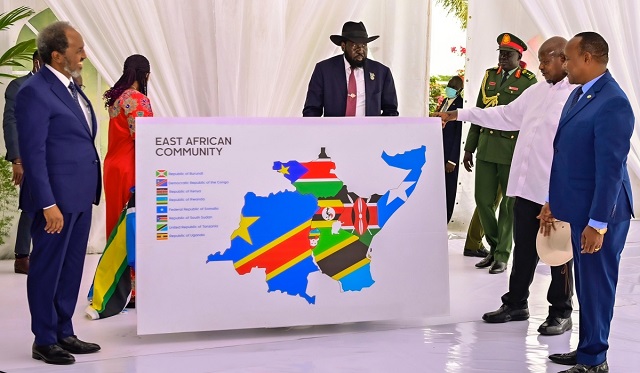The East African Community (EAC) is at a pivotal moment. With eight member states — Burundi, the Democratic Republic of Congo (DRC), Kenya, Rwanda, Somalia, South Sudan, Tanzania and Uganda — the organisation has ambitious integration goals, but the question remains: is the EAC still relevant and forward-looking in 2025? And what exactly is the administration doing to steer it?
Who’s in charge — and how the institution is structured
• At the top is the Summit of Heads of State, the highest decision-making organ of the EAC.
• The day-to-day administration is handled by the Secretariat, headquartered in Arusha, Tanzania.
• Since June 2024 the Secretary-General is Veronica M. Nduva (of Kenya) — the first woman to hold the position.
• The Secretariat also is supported by several Deputy Secretaries-General, each managing different portfolios (trade, customs, legal affairs) and appointed on a rotational basis.
• The major organs of the EAC include the Summit, the Council of Ministers, the Coordinating Committee, Sectoral Committees, the East African Legislative Assembly (EALA), the Court of Justice and the Secretariat.
In short: the EAC has a formal, multilayered administrative architecture. One advantage is that decision-making can proceed across multiple levels; one challenge is that coordination often proves slow.
Under Secretary-General Nduva the EAC has emphasised several priorities:
• Strengthening economic integration, including improved intra-EAC trade, infrastructure connectivity, and value-added production across the region.
• Promoting innovation, entrepreneurship and job creation, particularly for youth and women. Nduva explicitly flagged these as priorities upon assuming office.
• Addressing peace, security and institutional strengthening — the idea being that regional prosperity requires stability.
• Increasing emphasis on sustainable development, climate resilience and infrastructure financing through public-private partnerships (PPPs).
Additionally, the Treaty goals remain intact: a Customs Union, Common Market, Monetary Union and, ultimately, a Political Federation. These remain overall objectives that guide planning.
Successes
• The membership expansion: with Somalia becoming a full member in March 2024, the EAC has expanded its footprint and increased its strategic relevance. 
• Institutional reforms: the appointment of Nduva, first female SG, is a visible signal of change and inclusivity within the EAC.
• Some progress on trade facilitation and mobility: fewer visa restrictions, improved transport corridors, some harmonised regulation.
Challenges
• Integration is moving slowly. While the goals of a Monetary Union and political federation remain, few concrete steps have been taken in the last year to accelerate these.
• Uneven performance across member states: economic disparities, governance issues and security problems (especially in DRC, Somalia, South Sudan) strain the integration agenda.
• The Secretariat and member states continue to grapple with institutional capacity, funding, and implementation bottlenecks—policies often exist on paper but lag on the ground.
• There are concerns among observers that the EAC risks becoming reactive rather than proactive: responding to member-state problems rather than driving bold, strategic integration initiatives.
Is the EAC still relevant—and forward-thinking?
The EAC remains relevant for several reasons:
• It is the largest regional economic bloc in East Africa by membership and potential market size.
• It offers member states a platform to coordinate policy, negotiate trade deals, and pool infrastructure-investment.
• It provides a framework for regional stability (via common markets, customs union) which is increasingly important in a globalising world.
However, on the question of being forward-thinking: the verdict is mixed. On the one hand, the bloc has identified innovation, youth employment and entrepreneurship as priorities — something many older regional bodies have neglected. On the other hand, the pace, and implementation of these forward-looking priorities remains moderate. There is also lingering scepticism among business and civil-society leaders about whether the EAC can deliver tangible individual-citizen benefits (jobs, services, incomes) rather than large-scale policy swathes.
What can the EAC improve? Key recommendations
1. Faster, tighter implementation: Move beyond high-level declarations by setting clear, measurable milestones (e.g., intra-EAC trade growth, youth employment numbers, entrepreneurship start-ups) and publishing regular performance reports.
2. Prioritise “bottom-up” integration: While inter-government coordination is critical, more attention is needed on how ordinary businesses, workers and citizens benefit (for example through accreditation of professional qualifications, sectoral mobility, easily accessible cross-border trade).
3. Harmonise regulation and reduce duplication: Many member states still have differing regulations that impede seamless trade and mobility; the EAC should strengthen ex-ante regulatory alignment and cut red-tape.
4. Strengthen institutional capacity and funding: Ensure that the Secretariat and sectoral organs are properly resourced, with a focus on monitoring & evaluation, data transparency and regional programme delivery.
5. Maintain selectivity and quality in expansion: With new members like the DRC and Somalia, the EAC must ensure that added membership strengthens rather than weakens the bloc’s cohesion, particularly when governance and stability differ widely among states.
6. Enhance private-sector and civil-society engagement: Member states and the Secretariat should deepen the role of non-state actors in the integration process, to ensure the agenda reflects business realities and citizen concerns.
If the Secretariat and member states succeed in bridging policy and action, the next 2-3 years could mark a new chapter of progress. If not, the EAC risks remaining a well-intended but under-delivered regional experiment — valuable, but less transformative than it might have been.
The East African Community (EAC) — Still Relevant?

